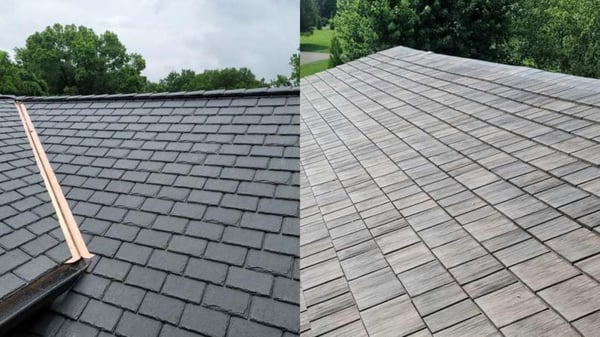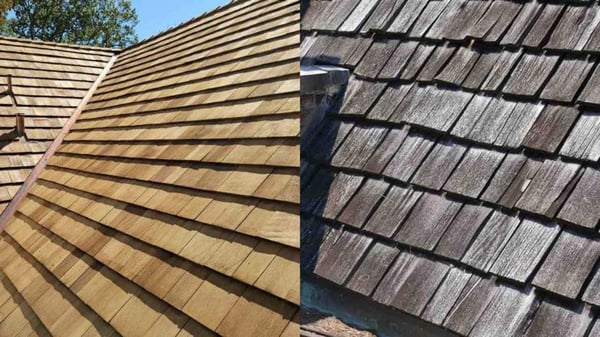Are you interested in composite shingles? Need to know how long a composite roof lasts before deciding?
A roof's lifespan is how many years you get out of it. So, you should think of it as the return on investment when getting a new roof.
That’s why lifespan should always be a big consideration when choosing any roofing material. So, it makes sense that you want to know how long a composite roof lasts.
For over 35 years, Bill Ragan Roofing has taken pride in giving homeowners the confidence to make the best roofing decisions with transparent information. To help you decide if it’s the right roofing material for you, let’s look at how long a composite roof lasts.
This article answers the following questions:
- What is a composite roof? (Quick overview)
- How long does a composite roof last?
- What are the other benefits of composite shingles?
What is a composite roof?
Composite (also known as synthetic) shingles are shingles made of a synthetic polymer or recycled materials (depending on the manufacturer) designed to look like natural slate tiles or cedar shakes. They have a rubber-like quality that absorbs or causes impacts to bounce right off the shingles.

They also aren’t as fragile as their natural counterparts, so you don’t have to worry about breaking or damaging them when working on the roof. Just know composite shingles are a “newer” roofing material in the roofing industry.
They’ve been around for a while, but there are still some unknowns with more manufacturers and brands coming out. Even so, composite shingles are becoming increasingly popular among homeowners.
In fact, I have a slate composite shingle roof on my own home. So, it really is up to every homeowner to decide if the “newness” is an issue.
How long does a composite roof last?
As long as it’s installed correctly, a composite roof should last around 40-50 years. The rubber-like polymer qualities make them durable and stand up well to the elements as the years pass.
This is usually backed up with a strong impact resistance rating from Factory Mutual (FM) or Underwriters Laboratories (UL). For example, DaVinci Roofscapes (the leading composite shingle brand) shingles have a UL-certified Class 4 impact rating, which is the highest rating a roofing material can have.
This means they stand up well to anything that hits your roof, including extreme weather, such as hail. If you’re looking for a long-lasting roof that stands up well to the elements, a composite roof is a great option.
What are the other benefits of composite shingles?
At this point, you know how long a composite shingle roof lasts. The long lifespan is a great selling point, but it’s not the only benefit to these shingles.
Let’s look at the other benefits of composite shingles to help you determine if they’re right for you.
Composite shingles are eco-friendly
You already know composite shingles are made from recycled materials (rubber and plastic) or a synthetic polymer. Well, this makes them one of the most eco-friendly roofing materials available.
Depending on the manufacturer, the shingles can even be recycled when it’s time to tear them off in the future. This may not be important to you, but the world is becoming more aware of our impact on the environment.
The roofing industry is simply responding by developing new roofing materials to become more environmentally conscious.
Composite shingles have high curb appeal
Because composite shingles are designed to look like natural cedar shakes and slate tiles, they provide very high curb appeal to a home. Manufacturers do such a great job of mimicking them that most people can’t tell the difference from the ground.
 (DaVinci composite cedar shake roof)
(DaVinci composite cedar shake roof)
For example, DaVinci Roofscapes (the synthetic shingle brand we trust the most) does this by paying attention to the fine details. DaVinci slate shingles are modeled directly from real slate tiles and add a hand-crafted touch with chisel marks to make them look authentic.
DaVinci cedar shake shingles have real grain patterns and deep grooves to create a shingle that looks just like real wood or cedar shakes. Designing them this way ensures it’s very hard to tell the difference between a composite shingle roof and the roofing material it mimics.
Composite shingles won’t show wear and tear
As they age, natural cedar shake shingles show signs of wear and tear, such as rotting, cracking, and curling. Composite shingles go through wear and tear like every roof when exposed to the elements, but they won’t show it the way natural cedar shakes do.
 (Left: Freshly installed cedar shakes; Right: Aged cedar shakes)
(Left: Freshly installed cedar shakes; Right: Aged cedar shakes)
This also means natural cedar shake shingles shift from a “fresh” cedar color to a more worn look as they age. The color change doesn’t mean something is wrong; some even like the worn/aged look.
You just won’t have to worry as much about the color fading with composite shingles.
Composite shingles are lightweight
A natural slate roof is so heavy that your house has to be built or retro-framed to handle the weight. This significantly increases the cost of one of the already most expensive roofing materials in the market.
Composite shingles are lightweight, so you don’t have to worry about the potential weight problems that come with natural slate. This still gives you the natural slate look you want with the added benefit of saving time and money.
Composite shingles are durable against storm damage
I already touched on this in the beginning, but the makeup of composite shingles gives them strong durability against the elements. F-wave and DaVinci synthetic shingles (two leading brands) have a Class 4 impact rating, the highest rating a roofing material can have.
This impact rating means they have been tested to withstand hail up to 2” in diameter without sustaining damage. However, most composite shingles can also handle wind speeds up to 110 mph to 130 mph.
Because of this, composite shingles are one of the most durable roofing materials against storm damage.
How much does a new composite roof cost?
After reading this article, you know how long a composite roof lasts and the other benefits this roofing material offers. While it’s newer, it’s a great option for longevity and curb appeal that stands out.
But unfortunately, composite shingles won’t be the right fit for many homeowners. And this comes down to one thing: price.
Composite shingles are considered a premium roofing material, which means you can expect a premium price point. So, the only real way to truly determine if they’re right for you is to know if they fit your budget.
Check out How Much Does a Composite (Synthetic) Shingle Roof Cost to learn if composite shingles fit your budget for your upcoming roof replacement.



